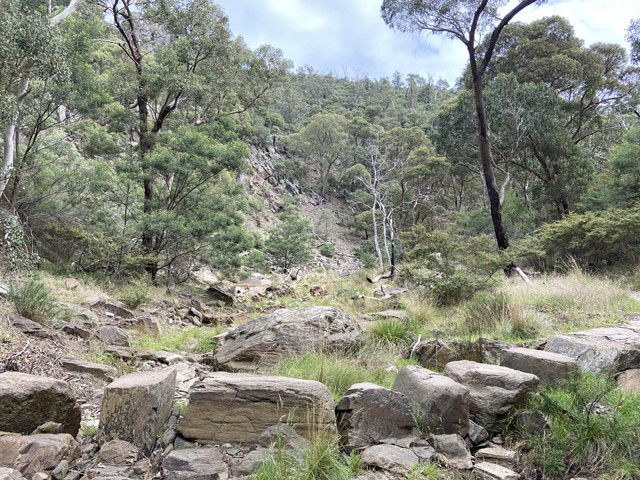Mount Wallace - Brisbane Ranges National Park


Little more than an hour's drive from Melbourne takes you to the state's richest wildflower habitat. Set in a low range of mountains dissected by rocky gullies, the unusual geology of Brisbane Ranges National Park has preserved plants that have long since vanished from the region, together with a correspondingly diverse bird population and the greatest density of koalas in Victoria.
Things to Do
- The 3 km Anakie Gorge Walk leads through the gorge between the picnic areas at Anakie Gorge and Stony Creek. Nelsons Track climbs to the ridge top to Nelsons Lookout with views over the gorge and Lower Stony Creek Reservoir. This is a high standard walking track which uses small foot bridges to traverse several creek crossings.
- Panoramic views over much of the Stony Creek catchment can be had from the Outlook. An easy 2.5 km return track, the Kurung Walk, climbs steadily from Stony Creek Picnic Area north to join Switch Road from where there are good views over the You Yangs and Anakie Gorge.
- The Burchell Trail is a three day walk through the park. Notes and a map for this walk can be obtained from the park office.
Facilities
- The camping area at Boar Gully is equipped with basic facilities and advance bookings should be made, particularly during holiday periods. You can book online or call 13 1963.
- Collecting firewood is not allowed, and campers should bring a fuel stove.
- Accommodation and supplies are available at Bacchus Marsh.
- Picnic grounds at Stony Creek and Anakie Gorge have wood barbecues (BYO wood), toilets, tables and seats.
- Anakie Gorge has one gas barbecue.
- Access roads are unsealed but well maintained.
- Be self-sufficient with drinking water. Carry it in and/or know how to make untreated water safe for drinking.
Heritage
The ranges were formed about a million years ago when a line of weakness, or fault, now known as the Rowsley Fault, developed in the earth's crust. East of the fault the land sank; to the west it rose, creating the rugged ranges. Streams cutting into the fault line have formed deep rocky gorges.
Wathaurong Aboriginal people lived in this area for many thousands of years, using its animal and plant resources sustainably. Today their descendants are based in Geelong.
Squatters arrived in the 1830s, concentrating their farming activities on the fertile land to the east and south along the Moorabool River. Gold was discovered in the Anakie Hills in the 1850s and the town of Steiglitz was born. Goldmining continued periodically until the early 1900s.
In the 1870s, the ranges began to play a new and vital role - supplying water to Geelong. 3000 ha of the Brisbane Ranges were reserved as a catchment area and a pipeline was built through Anakie Gorge to carry water to Geelong. Remains are still visible today.
Timber cutting for fuel, building and charcoal continued through the 20th century and much coppice regrowth can still be seen - there are few big old trees. There was also some quarrying for slate and decorative stone. Naturalists recognised the remarkable flora and fauna of the Brisbane Ranges, and in 1973 1132 ha of the ranges were set aside as a national park. The park was enlarged to its present size of 7718 ha in 1995.
Fauna
There are more than 180 bird species, which include the Peregrine Falcon, migratory Rainbow Bird and Powerful Owl. Mallee Fowl were found here but disappeared probably because they were hunted for food by gold-miners. Koalas are particularly abundant around Anakie Gorge. Other mammals include Swamp Wallabies, Eastern Grey Kangaroos and the nocturnal Brush-tailed and Ring-tailed Possum, Sugar Gliders and Tuans.
Vegetation
The diverse plant life is the park's outstanding feature. Its sandy soils support 619 plant species representing nearly a quarter of Victoria's native flora. The ranges are special for their wildflowers. Many of the plants are rare, or remote from their normal localities in East Gippsland and the drier west of the state. The locally common Brisbane Ranges grevillea is found nowhere else in the world.
How to Get There
The park is 80 km west of Melbourne via the Princes Highway. Turn onto the Ballan Road from Geelong or take the Western Freeway to Bacchus Marsh and follow the Geelong Road, turning off to Boar Gully.
Location
Brisbane Ranges Road, Mount Wallace 3342 View Map
Web Links
→ Brisbane Ranges National Park (Parks Victoria)
→ Brisbane Ranges National Park - Visitor Guide (PDF)
→ Friends of Brisbane Ranges on Facebook
→ Friends of Brisbane Ranges
→ Brisbane Ranges National Park - Map (PDF)
→ Brisbane Ranges National Park - Heritage Story (PDF)









